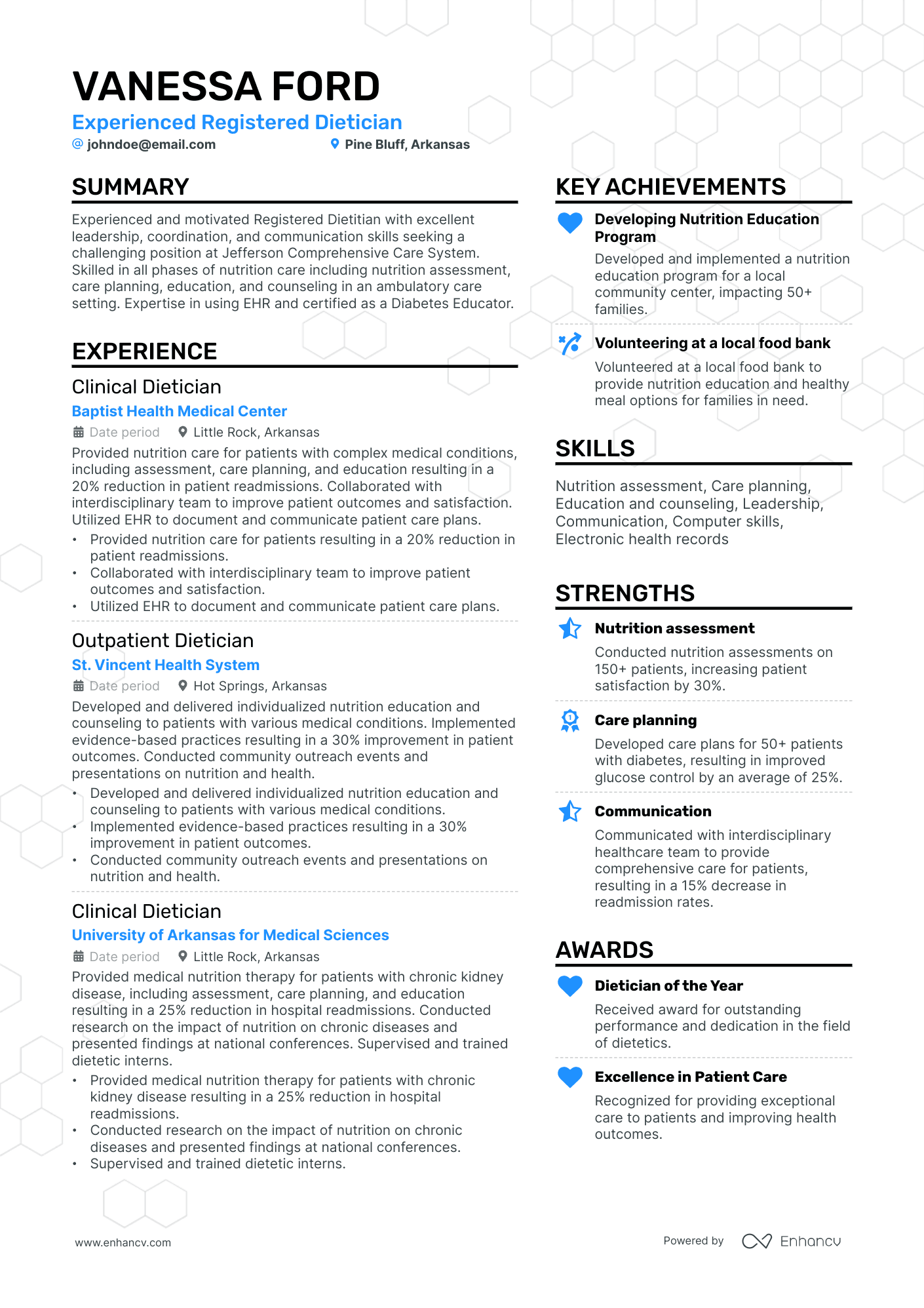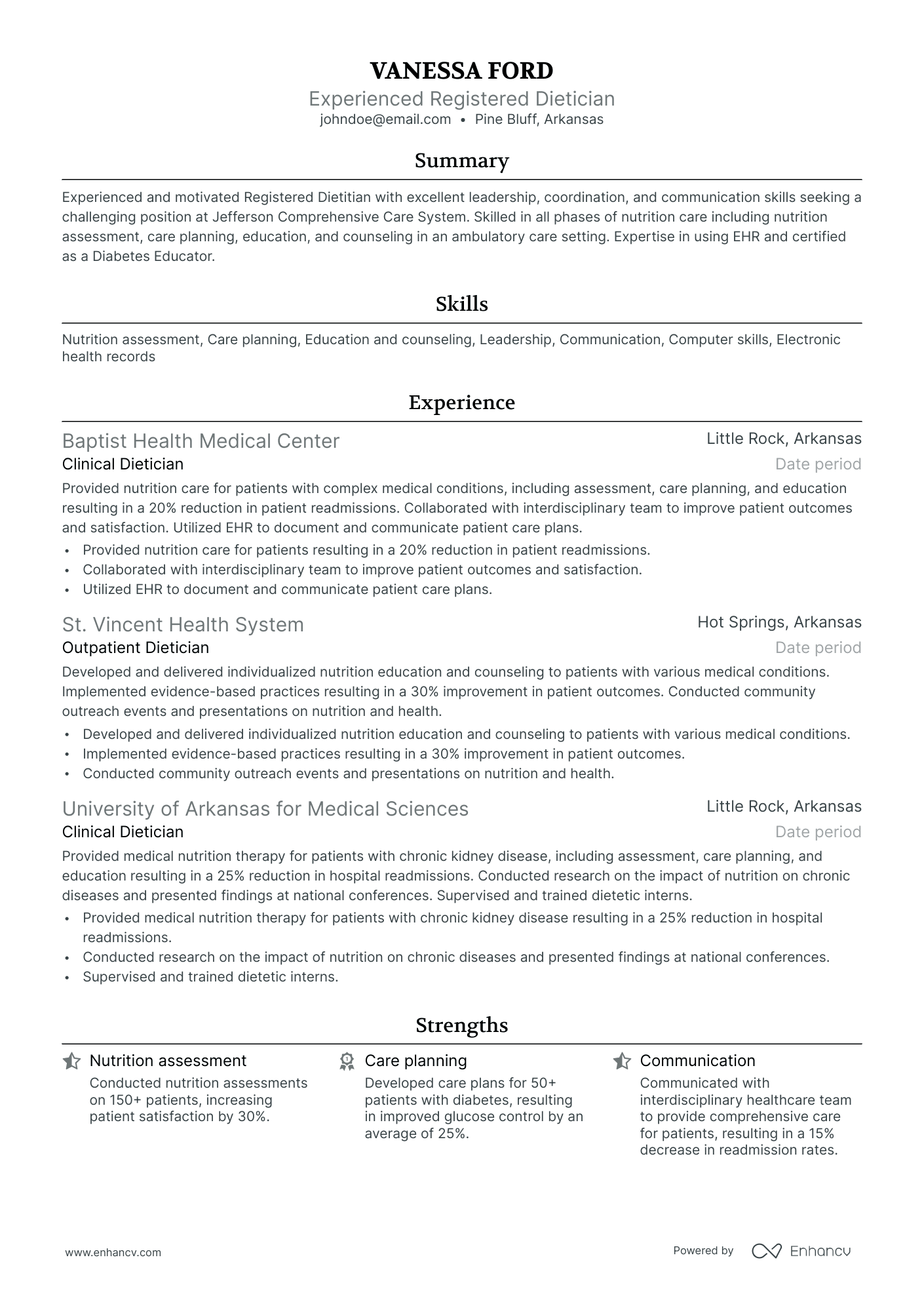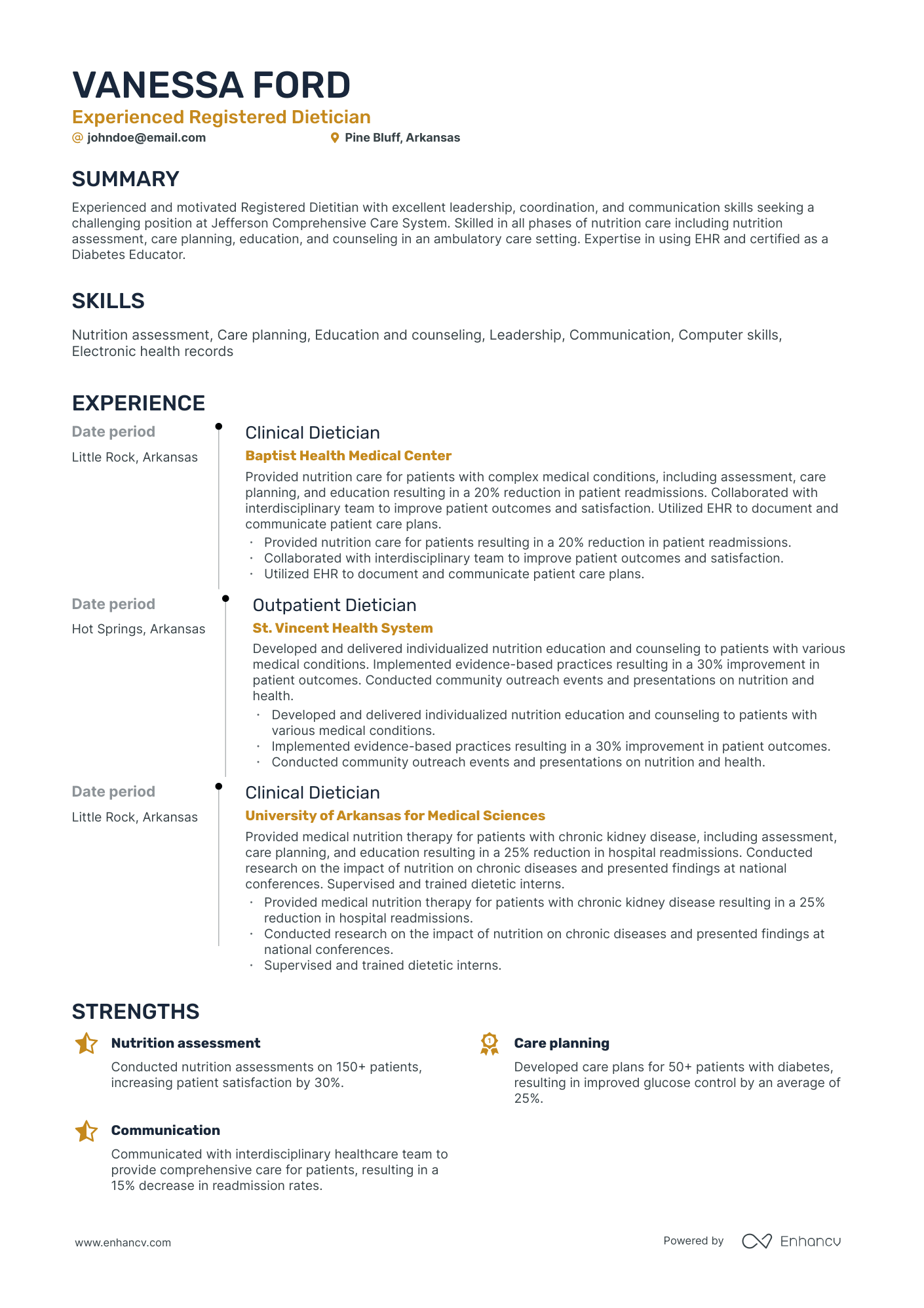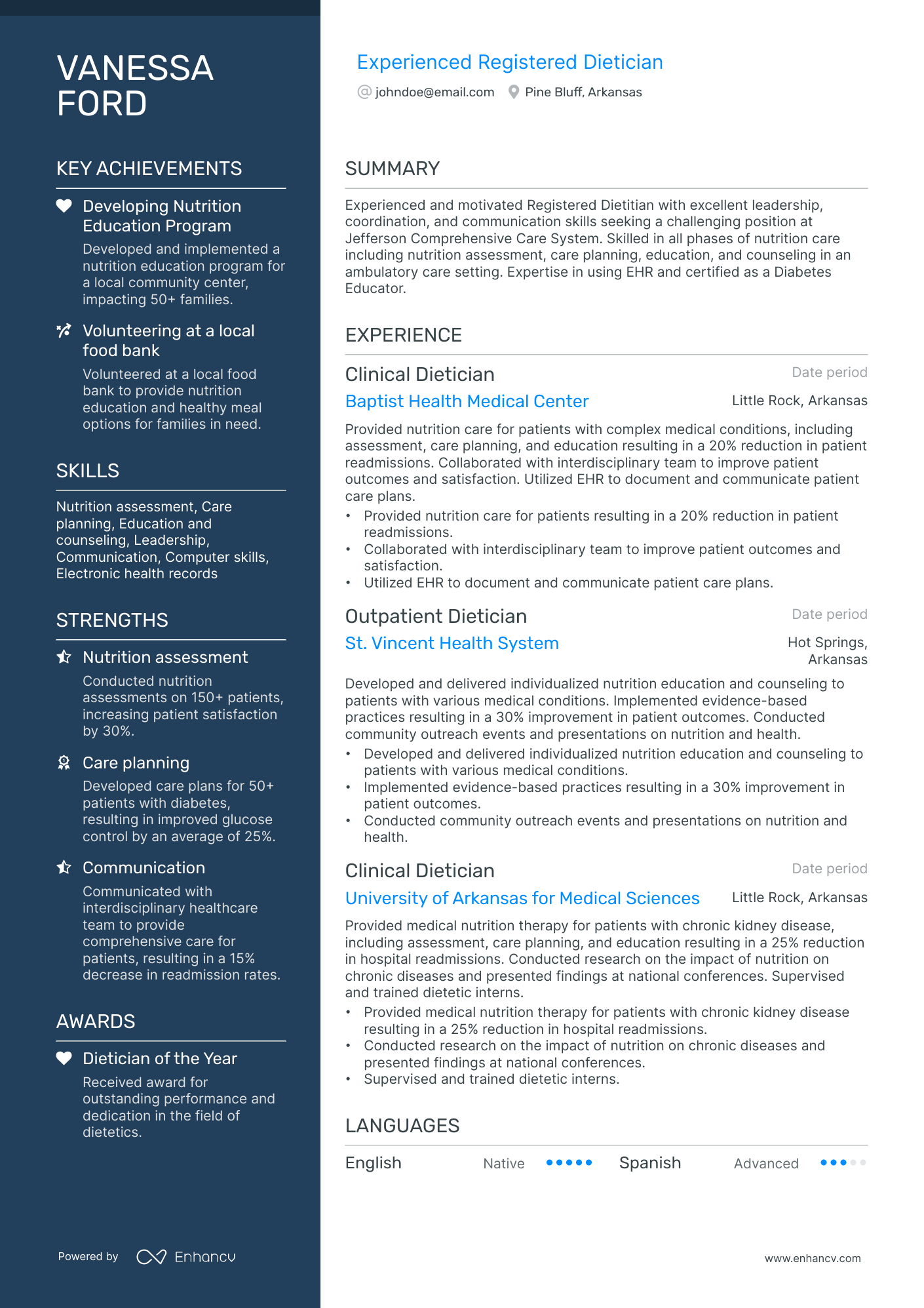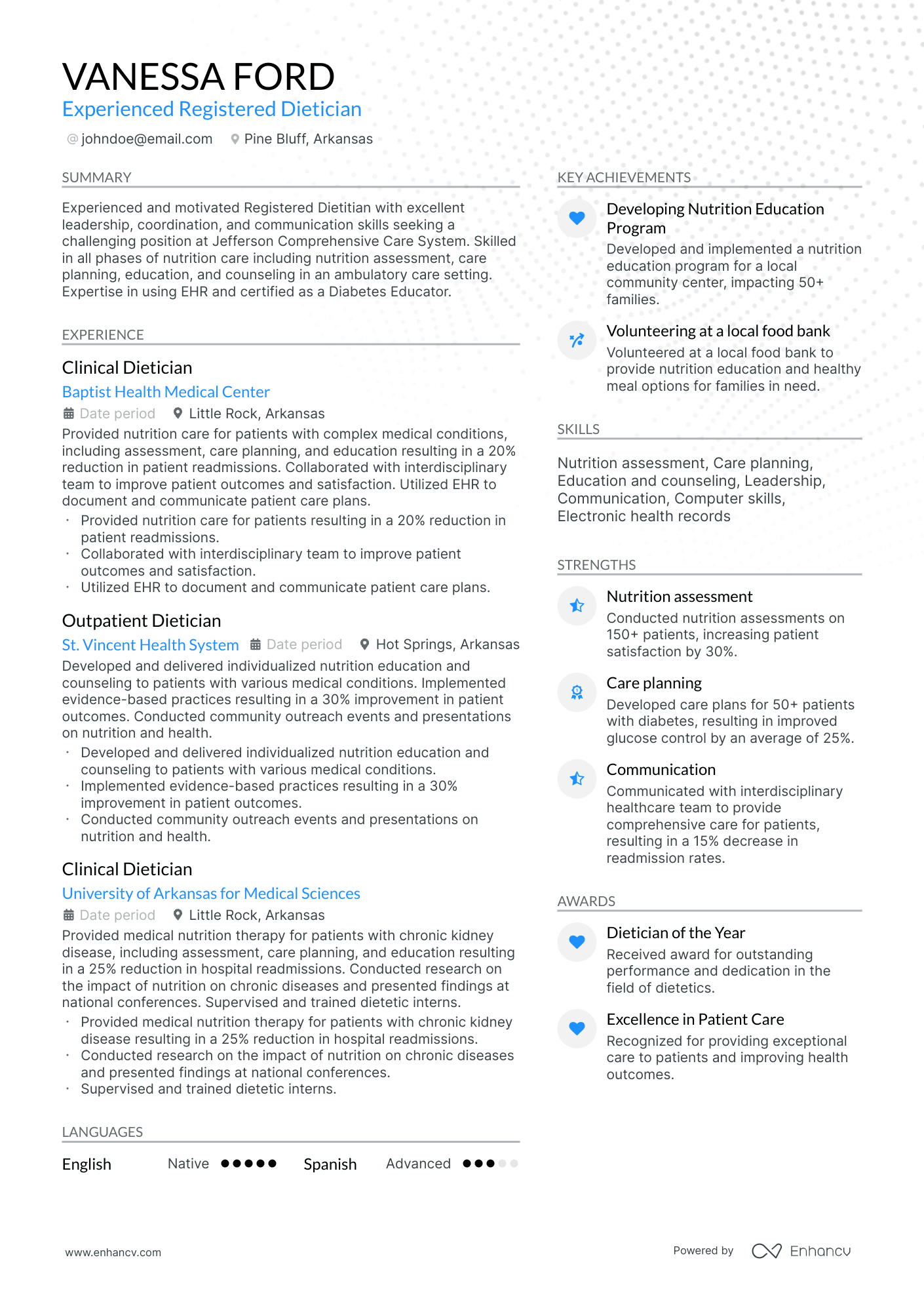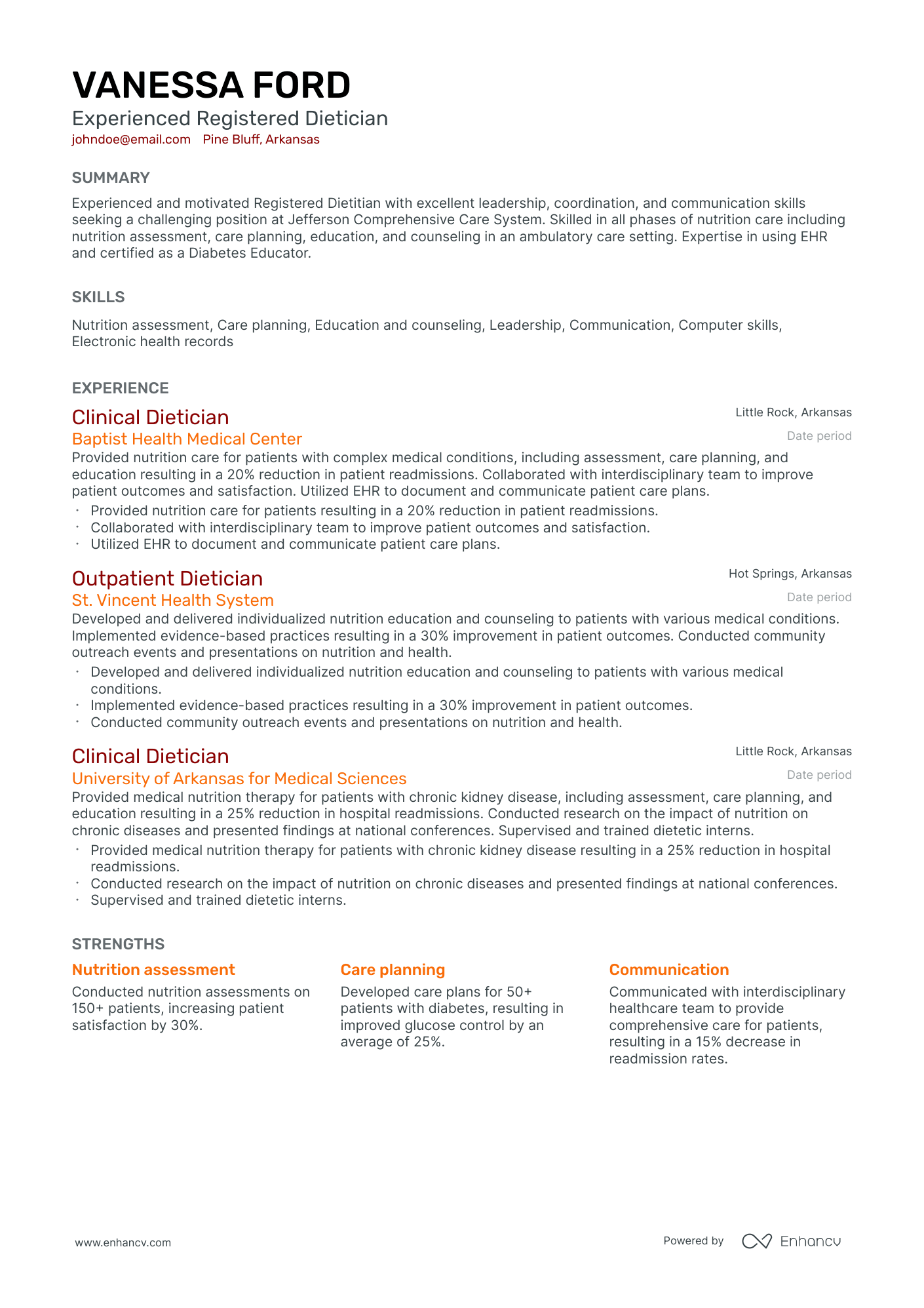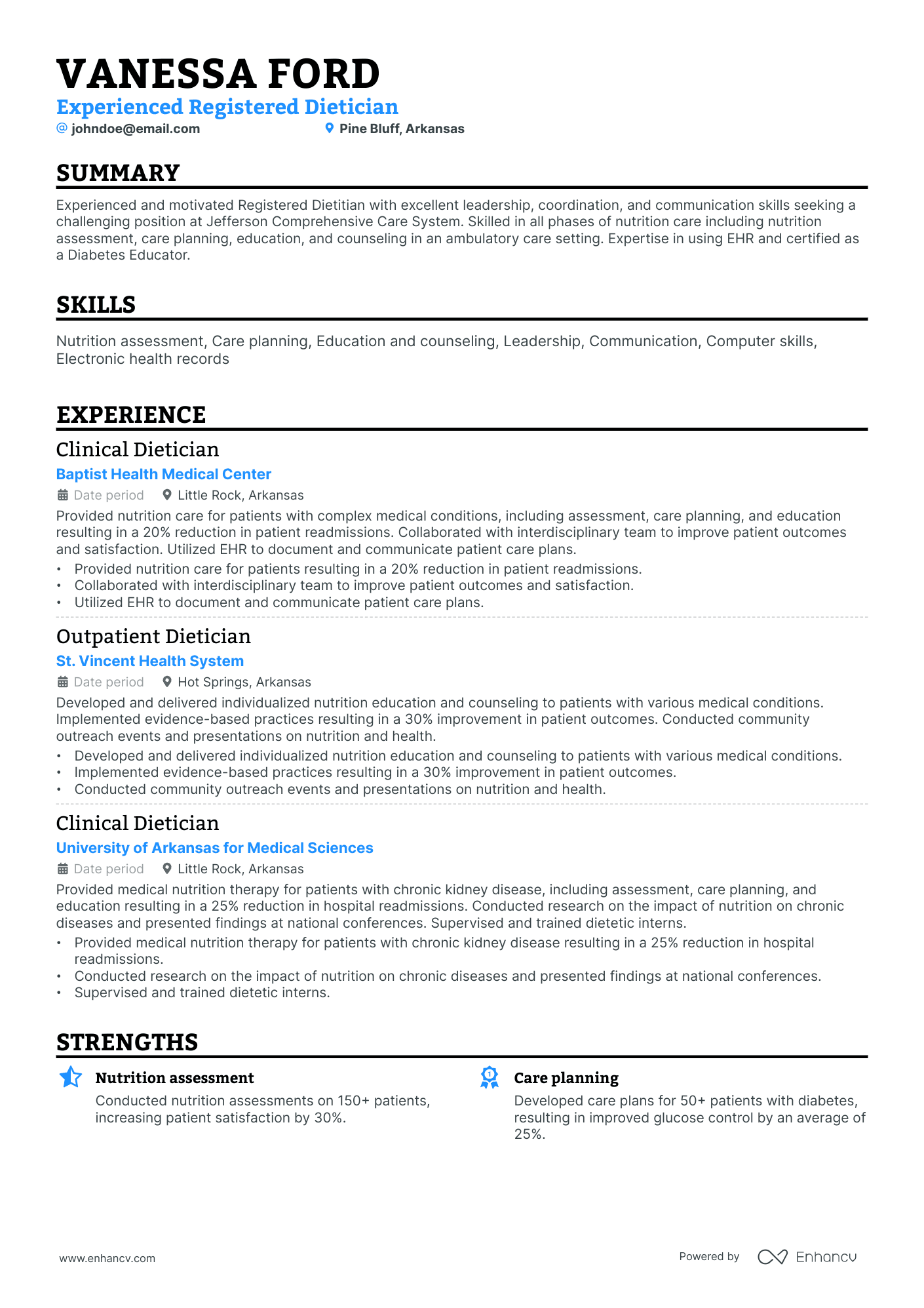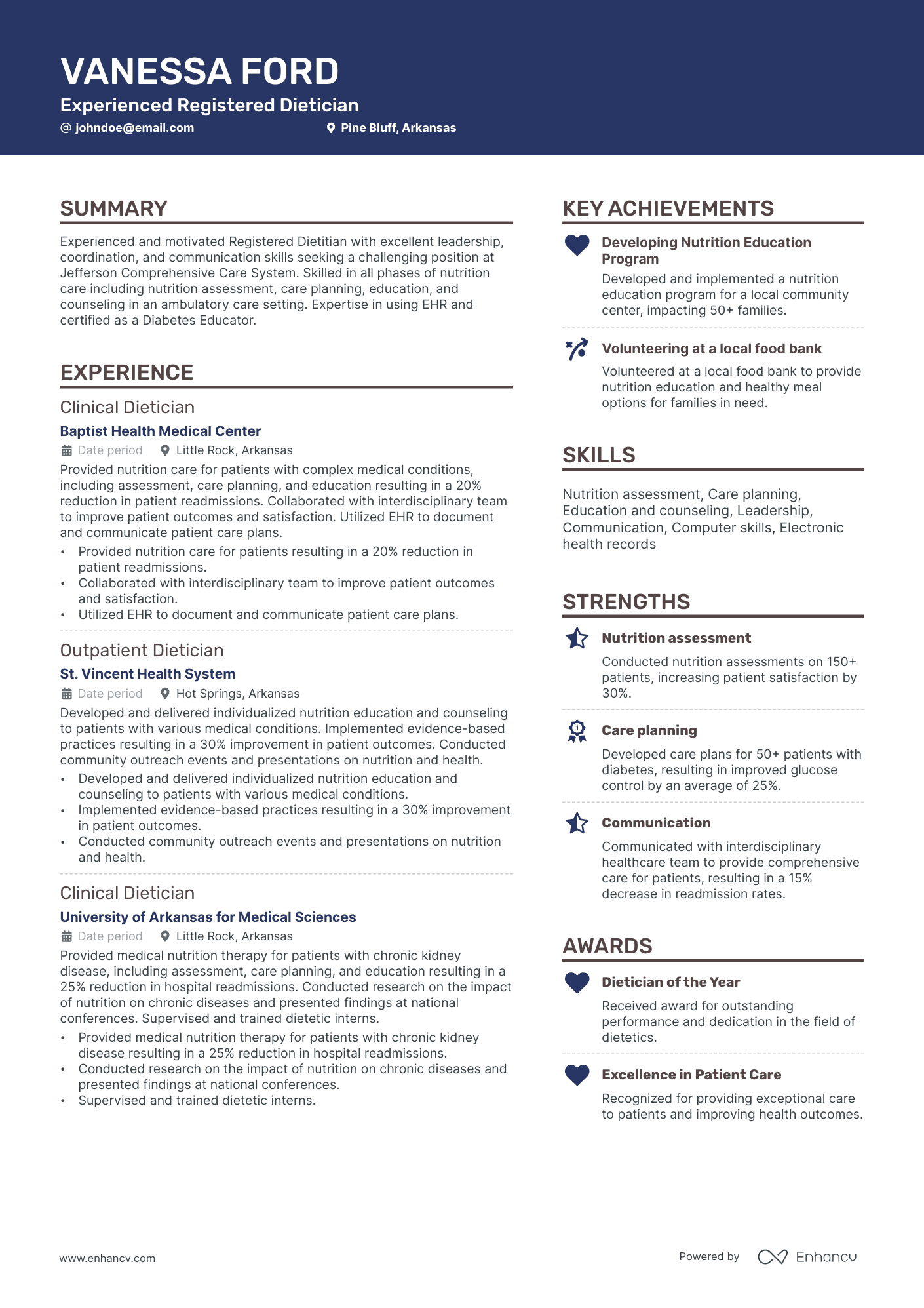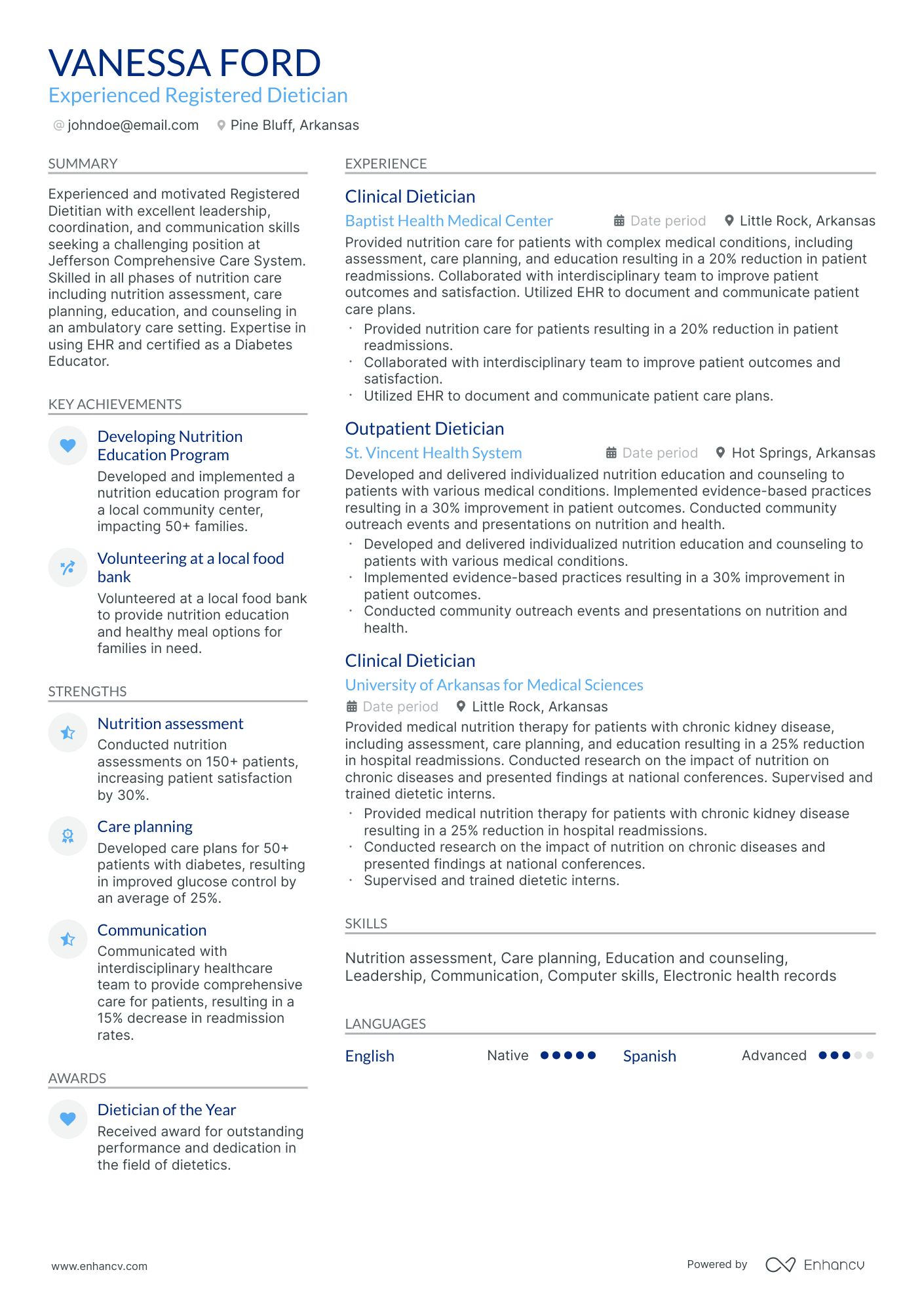Dieticians looking for a new job will find plenty of opportunities in a variety of industries, from healthcare and food services to education, sports and fitness, and many other fields. Because dieticians come from such diverse backgrounds, it makes creating an attention-grabbing resume that tailors to the job post a bit of a challenge.
In this guide for creating a professional dietician resume, we’ll discuss the common issues that dieticians face when crafting their resume, such as:
- Effectively using professional jargon in a way that HR staff, families, and others can understand.
- Tailoring your work experience to reflect your versatility while focusing on the specific requirements of the job post.
- Accurately detail your scientific and nutritional knowledge and interpersonal skills using multiple resume sections.
- Highlighting your connection to the industry through membership in the Academy of Nutrition and Dietetics or other national associations.
- Demonstrating your commitment to learning through workshops, seminars, and conferences that cover advances in nutrition research and dietetics.
We’ll use some real-world dietician resume examples to help you create a targeted resume that includes specifics from the job post, which will boost your chances of getting an interview.
If this dietician resume guide does not match your specific career objectives, check out these resume guides for similar roles:
Before we can add your relevant work experience, education, and hard and soft skills, you need to decide on the design and layout of your resume.
How to format a dietician resume
Formatting your resume is the first step in ensuring your resume passes applicant tracking systems and gets noticed by recruiters. You’ll need to use specific document settings, which include:
- One-inch margins on all sides: Margins help improve the overall readability of your resume and keep everything organized.
- A plain white background color: A white background with black text is more legible and gives your resume a professional look.
- Line spacing set to single space: This setting allows you to create more concise, compact sentences and get enough information on a single page.
- Font size between 10-12 points: A font size between 10-12 points is the optimal setting for all print media and is becoming the standard font size for digital media as well.
- Two-page limit: The industry-standard page length for your resume is two pages as it gives you enough space to list your skills and experience.
- Document type: When you submit your resume, send it as a PDF document. This is the standard format for all resumes and will retain the look and feel of it, no matter what operating system they open it on.
These are the typical settings for most new Word or Google Docs, so there is not much you need to worry about here.
Not all resumes are the same, and the design and layout you pick is a chance to customize it to your liking. Enhancv offers a wide range of resume templates which you can choose from.
Where you are in your career will determine which format you should use for your resume:
- Functional resume: This format is for dieticians with little to no experience and focuses more on education and hard and soft skills.
- Reverse chronological resume: If you have a few years of experience as a dietician, this format lists your work experience, starting with the most recent job first and going backward from there.
- Chronological resume: For senior dieticians, you can list your past work, starting with the most relevant experience. You’ll need to pay close attention to the job post to know which experience you should highlight.
If you’ve looked online at other dietician resume formats, you’ll notice that some resumes have two columns. Which one is best for you?
Single-column resumes are better for entry-level dieticians with no to minimal professional experience as dieticians. It is a simple and clean layout. Try one of Enhancv single-column resume templates to see if you like it.
A two-column resume is better suited for more experienced dieticians. You can place more information on a single page and be more creative with the layout, including using a colored background, graphics, and text icons.
Another option you have is the font choice. Avoid decorative or script fonts as they are difficult to read and may not fair well with applicant tracking systems or HR teams. Only use a serif or sans-serif font, such as Volkhov, Rubix, Railway, Montserrat, Lato, and Exo 2.
If you prefer the classics, like Arial, Times New Roman, and Courier, these are still acceptable to use, just a little old school.
Enhancv includes a number of modern fonts when you use our resume builder.
Keep in mind market-specific formats – for example, a Canadian resume might follow a different structure.
If you have a resume ready to go and like to see how well it compares to others, run it through our resume checker for a free analysis.
Is your resume good enough?
Drop your resume here or choose a file. PDF & DOCX only. Max 2MB file size.
After choosing a layout, you’ll need to add these sections:
The top sections on a dietician resume:
- Contact information: You’ll want to include your full name and various ways to reach you, including phone, professional email address, social media account, or personal website.
- Career statement: This section is where you will detail your career experience and highlight the field you specialize in and career accomplishments, published articles, or awards.
- Education and qualifications: Include post-secondary degrees in food science or public health, along with any certifications detailing specified nutritional training.
- Work experience: A detailed list of up to 3 relevant jobs that includes specific accomplishments and quantifiable dietician metrics.
- Skills and competencies: Demonstrate a wide range of personal and learned skills, such as dietary planning, patient counseling, and nutritional assessment skills.
Before you start adding the details of your career, you’ll want to focus on:
What recruiters want to see on your resume:
- Academic credentials in nutritional science or dietetics: This is a highly skilled position, and you need to show recruiters that you have the educational background through bachelor’s, master’s, or doctorate degrees in clinical nutrition, dietetics, or nutrition and dietetics.
- Professional certifications: Many dietician jobs will require advanced training through certifications and continuing education in pediatric nutrition, renal nutrition, sports dietetics, or other specialized fields.
- Experience in patient counseling: Recruiters like to see experience in relaying complex terms in a manner that patients and their families can understand.
- Clinical or Food Service Systems Management Expertise: Large-scale clinical or managerial food service experience is highly sought after, and recruiters often prioritize this expertise.
- Proficiency in dietetic software: Experience in various softwares like EatRightPro, DietMaster Pro, Healthie, and other industry-related software lets recruiters know you have the technical skills necessary for the job.
Now it’s time to start adding your relevant work experience in a way that makes recruiters want to call you right away.
How to write your dietician resume experience
The resume experience section is where you will list any professional experience where you performed the duties of a dietician. This will include full and part-time jobs at hospitals, private facilities, public health facilities, and other organizations.
For each job listing, you will include the following:
- Job title
- Company name
- Location
- Industry type
- Dates of employment
- 3-5 bullet points that detail your work experience
When you are listing your work experience, be sure to include relevant keywords that describe the work you did and how your efforts improved your client's nutritional health or improved the company’s work flow. Look for keywords in the job post to know what skills you need to highlight.
Doing this will give you a more targeted resume that attracts interest.
To give you a visual of how you want to tailor this section, let’s look at a real-world dietician resume experience example. This first example represents how most dieticians will detail their past work experience.
- •Design monthly menu schedules for prisons and university campuses, some with a daily need to feed several hundred people.
- •Apply the principles of contributing quality improvements through measuring, assessments, and monitoring.
- •Ensure staff is educated about preparation techniques to preserve food's nutritional content.
- •Keep up-to-date with official nutritional guidelines and portion sizes.
You can see how this example does little to describe this person’s accomplishments and the effect they had on the company. When including your resume experience, use action verbs to detail your work experience. “Designed” instead of “design” is how you want to format this section.
Your goal for this section is not just to list your duties and responsibilities. Recruiters know what these are already and don’t need a simple re-telling of them. What you want to do is show the impact you have by including actionable details.
We can easily improve this example by adding some relevant details about their accomplishments and other information.
- •Designed monthly menu schedules to include 3 nutritious meals and 3 snacks per day for prisons and university campuses, some with a daily need to feed up to 2,000+ people.
- •Applied the principles of contributing quality improvements through measuring, assessments, and monitoring, creating a more efficient cooking environment and a 23% reduction in ingredient waste
- •Ensured staff is educated about proper preparation techniques to preserve food's nutritional content, which improved client meal satisfaction scores by 79%.
- •Kept up-to-date with official nutritional guidelines and presented new findings to CEOs, kitchen managers, and food services staff.
- •Implemented new monitoring procedures to manage portion sizes, resulting in a $150K annual cost savings.
- •Recieved Outstanding Dietician of the Year Award in 2019 for the development of new meal plans that improved the health and well-being of university students.
Now, we have a better understanding of this person’s ability as a dietician and the positive effects they had on their past clients. These are the kinds of actionable results that recruiters love to see.
This example does a great job of:
- Quantifying several dietician metrics
- Demonstrates their interpersonal skills
- Showcases the effects of implemented policies
- Specifies the dietician field
- Highlights outstanding recognition in their field
If you are not sure which metrics to quantify, we’ll go over some of the top dietician metrics that you should include on your resume in the next section.
How to quantify impact on your resume
One of the biggest struggles that dieticians face when adding their resume experience is demonstrating their impact on the company. Most dietician resumes don’t quantify metrics like increased cost savings, improvements in client satisfaction ratings, and the number of meal plans created.
Using numbers and percentages allows you to detail the positive effect you had and gives anyone reading your resume a better sense of what you bring to the table.
To show you how beneficial this can be, check out these real-world examples of the top metrics for dieticians:
- Include the number of individual clients: “Managed a caseload of 20-25 clients and provided individualized nutrition counseling and personalized meal plans.”
- Percentage of increase in patient satisfaction: “Developed new nutritional menus based on patient feedback that led to a 73% increase in patient satisfaction ratings.”
- Total number of specialized nutrition plans designed: “Developed and implemented 15 nutrition plans that introduced new low-carb meals, vegetarian meals, and Mediterranean-style meals.”
- Number of interdisciplinary team meetings: “Collaborated with 4 interdisciplinary teams of healthcare professionals to provide nutrition counseling for patients with chronic conditions, resulting in a 30% reduction in hospital readmissions and a 20% improvement in patient satisfaction scores.”
- Number of food service employees supervised: “Managed a team of 75 food service employees and implemented new training procedures that resulted in a 30% improvement in employee performance.”
- Percentage reduction or cost savings in reduction of food waste: “Implemented stricter monitoring procedures for kitchen prep staff, which led to a 49% reduction in food waste.”
- Number of continuous education units (CEU) earned: “Currently have 38 CEUs in public health with a focus on pediatric nutrition.”
- Number of large-scale meal plans developed: “Provided nutrition assessment and education to an average of 780 patients and 1,400 staff in an 800-bed hospital.”
You only want to focus on the key metrics that are listed in the job post.
How do I write a dietician resume with no experience
If you don’t have a lot of relevant work experience under your belt, that’s ok. You can still create an impressive resume that demonstrates the skills that all dieticians need.
To format this section, you will list your past work experience in reverse chronological order. This will put your most recent work experience at the top of the list. If you are unsure which jobs to include, only list those jobs where you performed the duties of a dietician.
This can include any job where you:
- Supervised or participated in advising nutritionists, chefs, food service staff, managers, or other professionals.
- Communicated with patients about their dietary needs in a way that they fully understand.
- Demonstrated specific nutritional knowledge in pediatrics, sports nutrition, renal, and other dietetic specialties.
- Worked on complex issues and used problem-solving skills to resolve them.
- Successfully adapted to sudden changes in patient nutritional needs.
It’s these transferable skills that recruiters are interested in seeing from first-time dieticians.
Dieticians with no work experience can also add any volunteer work at food banks, community shelters, or meal delivery services to showcase their non-professional experience and dedication to the field.
Adding an internship that you participated in can also fatten up your resume and gain valuable experience.
How to list your hard and soft skills on your resume
The resume experience section allows you to list a few hard and soft skills that relate to the job you are applying to. What are the hard and soft skills that dieticians need the most?
Hard skills include technical and business skills that you learn in school and on-the-job training. Essential skills such as meal planning, clinical dietetics, and experience in nutritional software and food service management programs are what recruiters want to see from their new recruits.
Soft skills are those personal skills that make you a good communicator and allow you to empathize with your clients and show compassion. They include skills like active listening, emotional intelligence, organizational skills, and patience. Having these skills will allow you to form closer connections with your clients and better understand their nutritional needs.
Take a look at this list of the top hard skills for dieticians.
Best hard skills for your dietician resume
- Nutrition assessment
- Dietary planning
- Clinical dietetics
- Food service systems management
- Menu planning
- Nutritional counseling
- Diabetes management
- Cardiovascular care nutrition
- Renal nutrition
- Pediatric nutrition
- Geriatric nutrition
- Weight management
- Allergies and intolerance management
- Nutritional analysis software
- Metabolic measurement devices
- Electronic health record systems
- Microsoft office suite
- Food safety procedures
- Use of calorimetry for diet plans
- Use of body composition devices
The top soft skills that dieticians need include:
Best soft skills for your dietician resume
- Active listening
- Empathy
- Communication
- Patience
- Leadership
- Time management
- Professionalism
- Critical thinking
- Passionate learner
- Interpersonal skills
- Problem-solving
- Adaptability
- Teamwork
- Organizational skills
- Creative thinking
- Motivational skills
- Detail oriented
- Stress management
- Cultural sensitivity
Enhancv offers a number of different resume sections where you can add these skills.
Next, we’ll look at how to add your education and advanced training in dietetics and nutritional planning.
How to list your certifications and education on your resume
dieticians need to be highly skilled and demonstrate a firm educational foundation. Without this section, your resume will may appear unconvincing.
When listing your courses in the education section, you will include:
- Degree name
- School name and location
- Dates of enrollment/graduation date
- A bullet list of course descriptions
You only need to include course descriptions if you have little to no work experience as a dietician.
If you have a Master’s or doctorate degree, you will list this with any post-secondary degree starting with your most recent education.
When listing your certifications and additional training, you can include these in the Enhancv certification section.
Because this is such a highly skilled position, registered dieticians need a minimum of 75 hours of approved continuing education credits every five years.
If you are looking to advance your skills and earning potential, consider applying for one of these dietician certifications.
Best certifications for your dietician resume
In the next section, we will go over creating a personal statement and how best to craft your introduction.
How to write your dietician resume summary or objective
If your resume is the foot in the door, then this section is your personal greeting, so you want to make a good first impression. How you do that will depend on where you are in your career path.
A resume summary summarization your career to date and is best for experienced dieticians with 5 or more years of experience. It highlights career achievements and continuing education while quantifying specified metrics. This is where you can further tailor your resume to the job description.
Let’s look at a real-world experienced dietician resume summary to see how best to craft this section. This example reflects how the majority of dieticians format this section:
After reading this example, would you hire this person? Probably not. They do a good job of detailing their leadership abilities and continuing education credit, but fail to include necessary information, like patient improvement rates or how their performance benefited the company.
The number one rule when creating your personal statement is to include specific details. Let’s see how adding relevant details can improve this drab dietician resume summary.
This example better details their years of experience and quantifies multiple metrics. Adding more details about the length of their career makes the final statement of “220 CEUs” more believable.
After reading this summary, we can gather:
- They are a Registered Dietitian Nutritionist with over 15 years of experience.
- The specific organization types they have experience in.
- An ability to lead and discern complex technical information to professionals and non-professionals.
- They have experience developing new nutrition plans that increase patient satisfaction.
- Highlights their continuing education journey.
If you only have a few years of experience as a dietician, you will write a resume objective. It’s more difficult to summarize a brief career, so you will list your career objectives and any continuing education courses you are currently taking.
You can see how, in just a few short sentences, you can still write an impressive personal statement no matter how many years of experience you have.
Optimize your resume summary and objective for ATS
Drop your resume here or choose a file.
PDF & DOCX only. Max 2MB file size.
Additional sections for a dietician resume
So far, we’ve discussed the five main sections of your resume: the header, personal statement, work experience, education, and skill sections. If your resume is feeling a little light, there are additional resume sections where you can add your relevant skills and other information that demonstrates your abilities as a well-rounded dietician.
Which section can you add? Enhancv offers a number of resume sections that dieticians should include:
- Professional affiliations: This section allows you to show recruiters that you are active in the industry, develop new business contacts, and monitor advances in dietetics and nutrition sciences.
- Spoken languages: If the job post calls for experience in a foreign language, add this section to detail your proficiency.
- Speaking engagements: If you are asked to speak at a conference or training seminar, this highlights your advanced knowledge of the subject matter.
- Awards and honors: This section allows you to showcase local and national awards or recognition in the field.
How to include publications on a resume
If you love to write and have written any blogs, articles, or books about nutrition planning, research articles, or books on specific dietary plans, you’ll want to include a publications section.
You will need the following information when listing publications:
- Article title
- Publisher
- Author name(s)
- Publishing date
- Link to the article or book
Key takeaways
The dietician field is one of the fastest-growing jobs in the food health industry today, with an expected 7% job growth by 2032. Throughout this guide, we talked about the common issues dieticians face when crafting their resumes and how to avoid them.
By now, you should have a resume that:
- Demonstrates your technical and interpersonal skills that are essential for all dieticians.
- Includes relevant keywords found in the job post to create a tailored resume that will increase your chances of getting noticed and scoring well with applicant tracking systems.
- Highlights your passion for learning and staying current with new advances in dietetics and nutritional sciences.
- Showcases your ability to articulate complex information in a way that everyone can understand.
